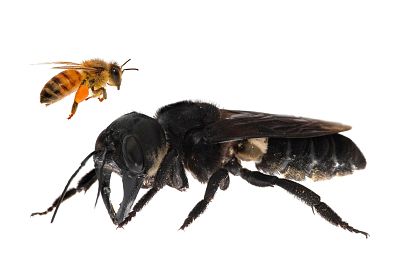"I simply couldn't believe it: We had rediscovered Wallace's Giant Bee," wrote a photographer on the research team that spotted the insect last seen in 1981.
The world's largest bee, last seen by a scientist in 1981, is not extinct after all.
A single female was found and documented earlier this year on an Indonesian island, an Australian university and other groups said Thursday.
The bee, Megachile pluto, also known as "Wallace's giant bee" named after British naturalist Alfred Russel Wallace who discovered it, was seen in January in the North Moluccas island group in Indonesia by an international team of researchers looking for the rare species, the University of Sydney said.
"Amid such a well-documented global decline in insect diversity, it's wonderful to discover that this iconic species is still hanging on," Simon Robson, honorary professor of the university's school of life and environmental sciences who was a member of the team, said in a statement released by the educational institution.
The bee has a wingspan of more than two-and-a-half inches and is considered the world's largest. Female bees make their nests in termite mounds, and the team found the single female giant bee in a termite nest in a tree about 8 feet off the ground, the university said.
A guide and conservationist, Iswan, climbed up and thought he saw something move, and entomologist Eli Wyman of Princeton University and the American Museum of Natural History climbed up and was certain that it was a bee's nest, photographer Clay Bolt wrote in an account of the discovery published online Thursday by the group Global Wildlife Conservation in Austin, Texas, which supported the effort and which runs a lost species program.
"The structure was just too perfect and similar to what we expected to find," Bolt wrote. "I climbed up next, and my headlamp glinted on the most remarkable thing I'd ever laid my eyes on. I simply couldn't believe it:
"We had rediscovered Wallace's Giant Bee."
A message to Bolt was not immediately returned Thursday afternoon. A message sent seeking comment from Wyman through the American Museum of Natural History, where he is a visiting scientist, had not been returned either.
The team traveled to Indonesia in late January, which was around the same time of year that the insect was encountered by Wallace and Adam Messer, who last saw the bee in 1981, Bolt wrote in the account published by Global Wildlife Conservation. It was found on the last day of a five-day stop in the area, the University of Sydney said.
"Messer's rediscovery gave us some insight, but we still know next to nothing about this extraordinary insect," Wyman said in the University of Sydney statement. "I hope this rediscovery will spark research that will give us a deeper understanding of this unique bee and inform any future efforts to protect it from extinction."
The size of the huge bee dwarfs that of a honeybee.
"It was absolutely breathtaking to see this 'flying bulldog' of an insect that we weren't sure existed anymore," Bolt said in a statement released by the university. Bolt took the first photos and video of the bee after the discovery, the university said.
The discovery raises hopes that more could be found in Indonesia's forests, according to the University of Sydney.
Lynn S. Kimsey, professor of entomology and the director of the Bohart Museum of Entomology at the University of California, Davis, was not involved in the search for the giant bee, but called the discovery significant. But she also that many insect species that have not been collected in a long period of time.
Kimsey, who did field work in the Indonesian island Sulawesi about the "warrior wasp," said tropical environments provide many places for species to go unnoticed.
"It's one of those things about tropical regions, that the environment is so complex that the chances of missing something are pretty damn good," Kimsey said.
"If you found one, chances are there's a population there," she said. "But finding a female is a good thing."












